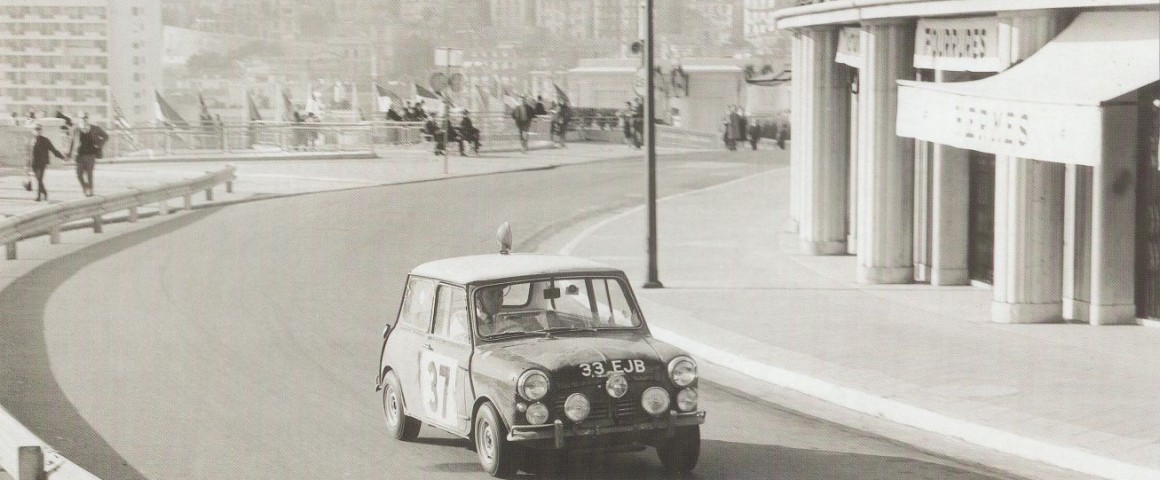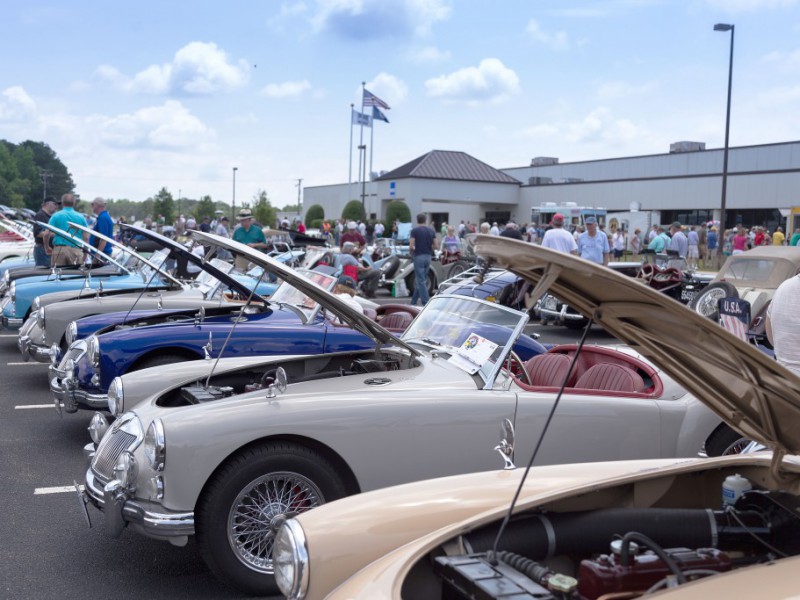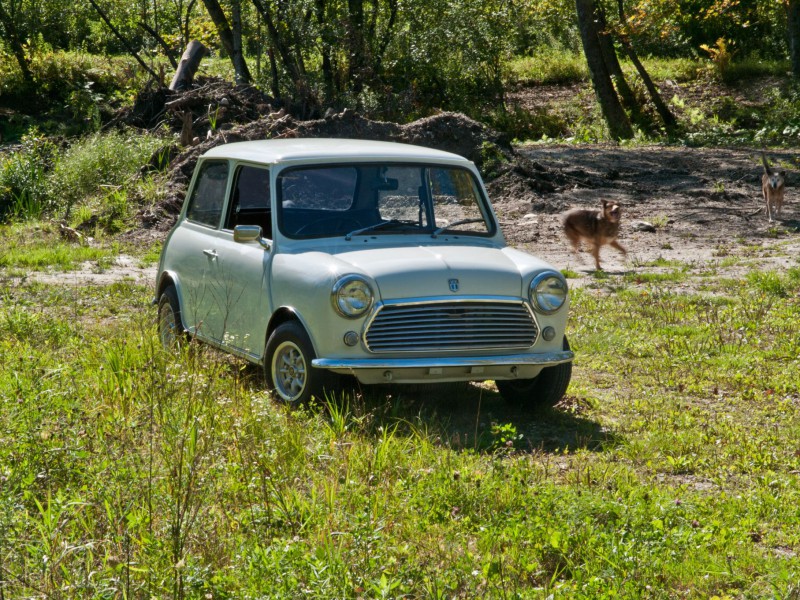By Graham Robson
Have you ever driven a Mini? Or sat in one? How frequently do you see one on the road? In the United States, maybe not often—yet in the UK they were once as familiar as hot dogs, fries and Coke. In other words, they were everywhere.
I bought my first new Mini in 1960, my second in 1962, went rallying in them in that same decade, and even saw them win the Monte Carlo Rally… three times. Even today, when most of the five million that were made have rusted away, I still see them regularly—mostly because I am regularly invited to commentate at events for enthusiastic owners. And yet, I have still never quite come to terms with the way that the original Mini was so small, that it was the first modern car to feature a transversely mounted engine, and was the first mass-produced machine to have front-wheel drive. Alec Issigonis (who conceived, but did not design all the detail—his team did that for him) takes the credit for that, although the major influence behind its invention was the Middle East War of 1956 when Israel and the Arab nations that surrounded it battled.
After that short-duration war, a massive worldwide oil shortage developed. Fuel rationing was imposed in several countries, including the UK, and tiny cars from Europe started selling like five-cent hamburgers. BMC’s chairman, Sir Leonard Lord, suddenly found that he had nothing on sale that could match them. Cue a typically short, explosive, and decisive meeting in 1957, at Longbridge, with his chief designer, Alec Issigonis, during which he apparently said something like: “Drop everything else you are doing, then go away and design me a new small car to beat the bloody Europeans. I don’t mind what it looks like, but you will have to use an engine which is already in production here.” And that was really all the ‘Product Planning’ that the new car got.
Lord chose Issigonis because he was already famous in the UK as the designer of the post-war Morris Minor (which was currently Britain’s best-selling small car), and he had recently been installed at Longbridge with his own secretive little team to design and develop future BMC models. Issigonis had already conceived a front-wheel-drive version of the Morris Minor (which was never approved—the cancellation being one factor that convinced him to eventually leave BMC), and immediately settled on that for his new car. Securing a BMC project code of ADO15 (ADO = Amalgamated Drawing Office), Issigonis’s team started work in 1957, were ready to show off prototypes to their bosses in 1958, and saw the car launched in August 1959. It was not long before it became the most popular car in BMC’s armory, and would remain in production until 2000. At first there were ‘Austin’ and ‘Morris’ types, using an 848cc engine, which only produced 34bhp, but a lot more variety—re-badging, re-engineering, and power boosting—would follow.
The Mini represented a complete breakthrough in automotive engineering, not only because it was a front-wheel-drive machine, but also because that engine was mounted across the line of the car (what is generally known a the ‘East-West’ layout), for this allowed the machine to be shortened even more than hoped. When it was launched, it was only 120in. long, running on an 80in. wheelbase, and weighing a mere 1,380lb. Originally there was only a two-door sedan, with sliding (rather than wind-up) windows, and it sold in the UK for only £497, and in 1960 its PoE price in the USA was only $1,295.

Issigonis with Mini number one at his retirement in 1972
Minimal motoring? Yes, for sure—and that was exactly what Sir Leonard Lord had hoped it would be—but it was also technically advanced. Not only was the A-Series four-cylinder engine mounted across the car (it was the same basic engine as used in Bugeye Sprites, by the way), but the four-speed stick-shift gearbox was mounted under that engine (in the sump, really), there was all-independent suspension by rubber cone springs, and—considering its size—an almost unbelievable package of four-seater accommodation.
Not that it was a fast car—nor even meant to be. Flat out, it might just reach 75mph. Later versions, such as the Cooper and Cooper S types, might nudge 90mph, but that was about the height of it. As to accommodations, there was just one instrument, mounted in the middle of the dashboard, the front seats were, shall we say, guaranteed to keep many chiropractors in business, and the build quality was decidedly ‘iffy’ at first. Both my Minis leaked, and suffered engine cut outs in heavy rain conditions, and overheating in hot weather was not unknown. Maybe this was why the original Mini was slow to catch on when it was put on sale in the USA. Not only because it was so small, but because it seemed to be so easily intimidated in heavy North American traffic. Even so, when away from being overshadowed by big, growling, Fords and Chevys, and away from the freeways which made it feel so insignificant, the Mini was a much more attractive proposition.

Mini prototype, 1957
Cute? Yes, ‘cute’ was a perfect word to describe this agile little machine, which could slip in and out of traffic hang-ups as if they were not there, handled better than any other road car on the market, and certainly punched above its weight when traction was needed on icy roads. Although no one in the USA, I guess, ever bought a Mini as their only car, British customers in the millions did just that.
Commercially and financially, of course, the Mini was a perfect case study for a Harvard Business School student, as there were times, for sure, when it was not making any profit for BMC, and there were times when demand was so high that other BMC models had to be quietly side-lined for weeks or even months at a time for Mini assembly to rule the roost at Longbridge and Cowley, where parallel production facilities were maintained for years.
Even so, like the VW Beetle, the Mini went on, and on, and on. But, like the Beetle (and, of more interest to people who read these pages, like the MGB and now the Miata) the Mini kept on changing, evolving and improving. Although the original 848cc Mini was listed in the USA until the late 1960s, it had already been supplanted by the more powerful Mini Cooper, and finally by the 76bhp Mini Cooper S before final imports were made. Limited sales, new US regulations, and all manner of bureaucratic hurdles got in the way. And although the exhaust emission regulations could be met, it looked as if the car could never meet the barrier crash tests that were now being required.

Riley Elf, 1963
Like the MGB, too, a comparison between the earliest and the late types showed that almost every facet of the car had changed over the years. Rubber cone suspension had given way to self-levelling water-based ‘Hydrolastic’ suspension, winding window glass had been adopted, most details surrounding the engine had been updated, all-synchromesh stick-shift gearing had been standardised, an automatic transmission was made available for some markets, and those of us based in the UK had also seen ‘Riley’ and ‘Wolseley’ badged versions appear, along with diminutive little station wagons, vans and even a sweet little pick-up truck version all going on sale.
There would be a lot more change to follow in the 1970s, ′80s and ′90s, but by that time British Leyland had been born, prospered, then hit hard times, parts suppliers found it more and more difficult to keep up with all the mass of changes which continued to be made. Even so, the A-Series engine continued (in MG Midgets, for instance), the transverse engine philosophy was adopted for other models (the Austin America appeared in 1968, for instance) and—most importantly—the original ground-breaking layout of a transverse-engine layout was taken up by car makers all over the world.

The Mini Moke—introduced in 1964
Having bought up the rights in the1990s, BMW set out to re-invent a new-generation ‘BMW MINI’ in 2001. They retained the site of one of the old factories which had previously built ‘classic’ Mini body shells, and made an excellent job of keeping the name, and the marketing approach alive. Nothing, however, could replace, or replicate, the character, and the sheer delight, of the original Mini, and although many of the 1960’s cars have now succumbed to rust and neglect, there are still examples, looking, feeling, and behaving in the same remarkable way as ever, on our roads today. It will be a long time before a real Mini replacement ever takes to the road.








'So Small It Could Only Be Called The Mini' has no comments
Be the first to comment this post!